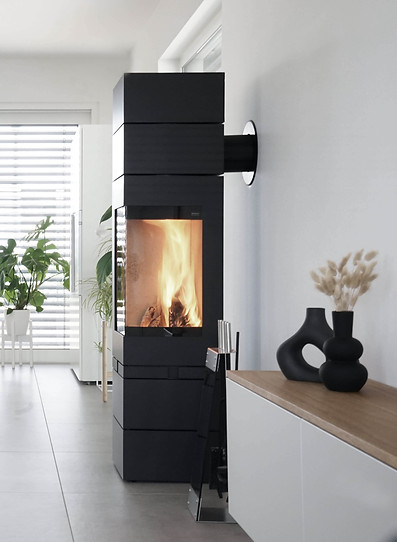Heating with wood:
Tips for clean burning fire
There is a lot of talk about the topic of "heating with wood". We therefore regularly receive questions about how to use a fireplace as cleanly as possible. We would like to guide you through a summary to explain the most important points and give you tips for the daily handling of your fireplace.

THE RIGHT WOOD
Which wood you use has a direct impact on the quality of the burn. The most suitable is hardwood. In particular, we recommend beech wood as your first choice. Softwoods are usually smoother and have a higher content of resin. They burn faster and produce more soot. That is why we advise you to use softwood only during the start of lighting. It is also fundamental for a clean burning fire that the wood is dry. Damp wood should never be burned, as this produces increased emissions that are harmful to humans and also harm the material in the long run. Freshly cut wood should be allowed to dry for approx. 2 years before it is used, or you can buy chamber-dried wood. The residual moisture should always be less than 20%. In addition, do not burn painted, impregnated or laminated wood. Nor should you add household waste, waste paper or liquids to your fireplace. Furthermore, we recommend using wood from regional stocks and sustainable forestry. This way you avoid long transport routes and can reduce CO2 consumption.


Light Fire
Clean and efficient burning is not just about what wood you use, but how and when you add wood. This has a direct impact on the emissions that are released. Before lighting a fire, be sure to fully open the oxygen controls on your fireplace. In addition, it is advisable that you open a patio door or window. This action helps equalize the pressure in the room and promotes smoke evacuation in the chimney. When lighting the fire, use as many small pieces of wood as possible. . This will allow you to reach a high temperature as quickly as possible so that the wood burns without leaving any residue. When the fire is burning sufficiently, you can close the stove door and then adjust the oxygen regulator to the flame. You should always add more wood when the flame is almost extinguished. Then the least pollutants and emissions escape.
TECHNOLOGY FOR THE FUTURE
A new fireplace can hardly be compared with the models of 20 years ago. Manufacturers are working hard on new technologies to make the performance more and more efficient. These efforts are also reflected in the certification of the "Blue Angel - the German Ecolabel", which some models of stoves have received. The goal of the measures is always that the fire is as clean as possible. This is what you get when the air regulator on your fireplace is optimized. Some of our manufacturers rely on automatic control here. Basically, when buying a fireplace, you should make sure that the manufacturer finishes high-quality stove and fireplace components and that they comply with current standards. When choosing our partner companies, this is also an important aspect for us. Therefore, we only work with companies that share this high quality standard. We will be happy to advise you in detail in a personal meeting.
